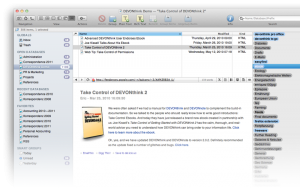

#DEVONTHINK PRO OFFICE APPLESCRIPTS ARCHIVE#
Instead of jumping to another page, as with other bookmarks, the bookmarklet will create either a link document or a Web archive for the displayed page in your DEVONthink Professional database.īookmarks or Web archives created using these bookmarklets will be created in the group defined in the preferences, “Import” tab, for “New notes.” This works extremely slickly for saving entire Web pages as Web archives, which can of course be displayed in DEVONthink Pro’s built-in Web browser.ĭEVONthink Pro 1.2 is also significantly faster than the previous version 1.1, which is great news, because while I love DEVONthink Pro, it has up to now been a tad sluggish, even on my 1.33 GHz PowerBook with 1.5 GB of RAM. To use a bookmarklet, load any page that you want to archive - then select the bookmarklet of choice in your bookmarks bar. ¥Ědd page as Web archive to DEVONthink Professional

Basically, they “misuse” bookmarks as handy shortcuts for application functions.ĭEVONthink Professional supports the following two bookmarklets: DEVONthink Professional supports two bookmarklets that add a displayed Web page either as link or as Web archive to the currently open database. DEVONthink Pro is particularly useful if you have a large quantity of information that needs to be cross-referenced, indexed, searched and retrieved - providing powerful database functions without a lot of database geekiness.ĭEVONthink Professional Edition 1.2 includes several new features, such as support for bookmarklets, which are JavaScript commands added to the bookmarks of a bookmarklet-enabled Web browser, e.g., Safari or DEVONagent 2.0.2, that perform a function instead of loading a stored Web address.

A hierarchical filing structure and AI functions for sorting in and finding documents makes it ideal for both, keeping a simple notebook and organizing large information collections. DEVONthink intelligently stores your text files, PDFs, images, bookmarks, even QuickTime movies and MP3 files, and helps you organize them in one database, regardless of where the data is physically located, and integrates both local documents and live content from the Internet to keep, e.g., all project-related information together. If you’ve never checked out DEVONthink, it’s a “document and information manager” - a notepad, outliner, scrapbook manager, information manager, freeform database, archive, bookmark manager and image database, and also includes a built-in Safari-based Web browser and RSS newsreader. DEVONthink Professional version 1.2, which was released last week, is the best yet by a significant margin, particularly in the speed department. It’s been for the most part an impressive piece of software, and has only gotten better with continued development. I’ve been using DEVONthink Personal Edition, and more recently DEVONthink Professional, as my main information storage and retrieval managers for research data and suchlike for several years now. However, if you have a lot of archive data to organize, store, and search through frequently, there are better solutions then just depending on the Finder and Spotlight. Nevertheless, those complaints registered, even a lame and clunky Spotlight is better than no Spotlight. I would also like more versatility for searching within results. There are some maddeningly annoying things about Spotlight, two particularly notable ones being its inability to search for phrases, and the complexity of doing simple filename searches. Once I got used to its idiosyncrasies and angularities, I’ve found that Spotlight in OS 10.4 Tiger helps a lot. Indeed, one of the challenges of contemporary computing is simply finding stuff on your hard drive even if you know it’s there somewhere, and generally keeping your archived data organized. The concept really wouldn’t work today very well. The average PowerBook user then had only a handful of programs and relatively few documents. Of course, in the early and mid-’90s, it was quaintly easy to describe the contents of most people’s hard drives in a few lines. Various celebrities would pose for the magazine advertisements holding their PowerBooks, with an inventory of what was on their hard drives listed below. “What’s on your PowerBook? was one of my all-time favorite Apple advertising campaigns. Home > Columns > Charles Moore The 'Book MystiqueĭEVONthink Professional 1.2 Keeps Track Of “What’s On Your ‘Book”


 0 kommentar(er)
0 kommentar(er)
